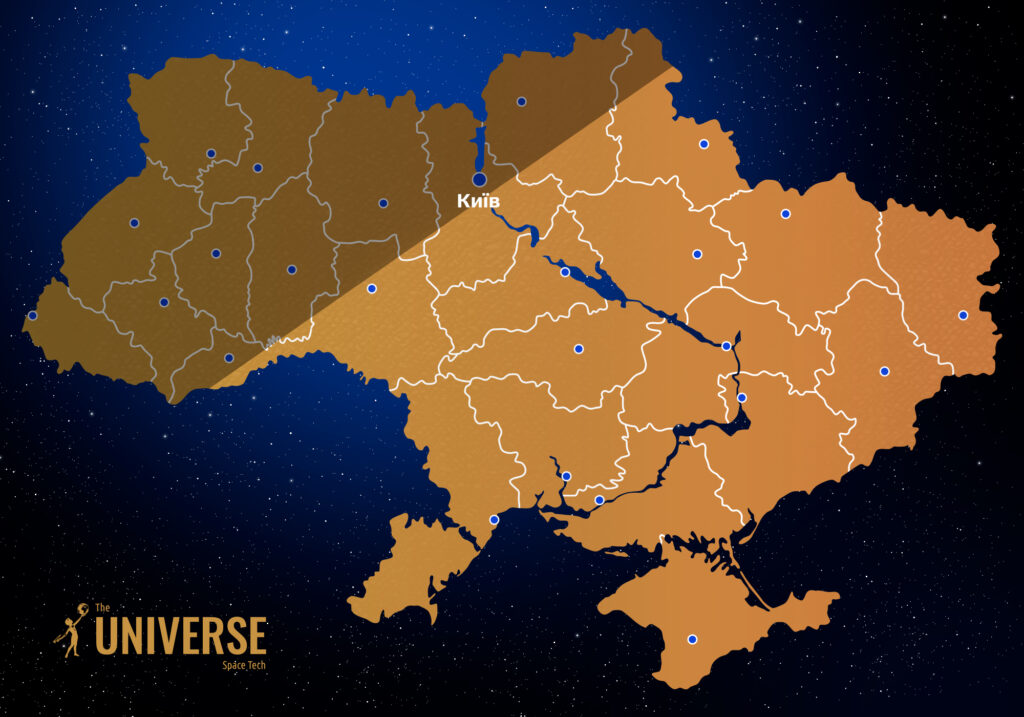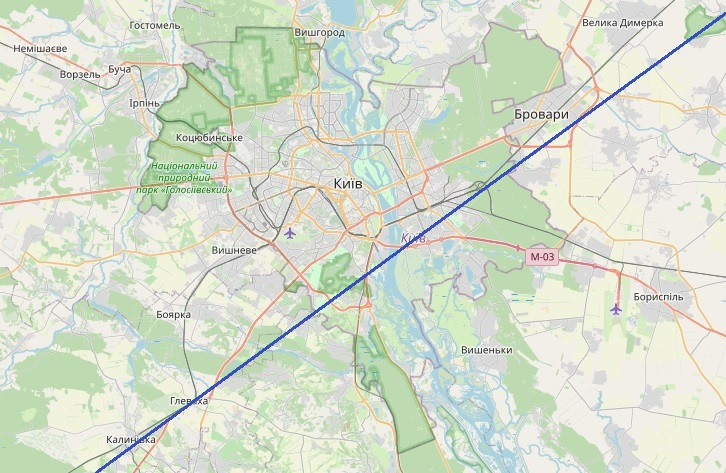On March 29, the Earth will experience a solar eclipse. In Ukraine, it will be barely visible. But there will be a place on our planet where the Moon will cover 94% of the solar disk. Read the article to find out where exactly.

Total solar eclipses can be observed only in a narrow band “drawn” on the Earth’s surface by the lunar shadow (the diameter of the cross-section of its cone rarely exceeds 200 km). The situation with annular eclipses is not much better. During them, the apparent size of the Moon’s disk is smaller than that of the Sun, and they occur more often than total eclipses. Outside the band of the total or annular phase, i.e. in the penumbral zone, there is a partial eclipse: the solar disk is visible there, but only partially covered. It happens that the axis of the cone of the Earth’s shadow does not fall on the Earth at all, but a wide penumbral cone still covers it. Such an eclipse is expected on March 29. Its peculiarity lies in the fact that it will have an excellent maximum possible phase – almost 94%. Will we be able to see it in Ukraine?
The eclipse will reach its maximum phase at a point with coordinates 61°06′ north latitude and 77°06′ west longitude, located west of the Labrador Peninsula (Quebec, Canada). At 4:47 a.m. EST (9:47 a.m. GMT), an unusual sickle-shaped Sun will rise there, with a maximum thickness of only 6.4% of the solar disk’s diameter. At this moment, the lower edge of the lunar shadow cone will be at an altitude of less than 200 km above the specified point. If some space observers (for example, astronauts aboard the ISS) accidentally get into it, they will be able to see the solar corona.
Further, as the luminary rises above the horizon, the thickness of the solar sickle will increase, and the phase of the eclipse will decrease, respectively. It will also decrease with distance from the maximum point to the south, east, or southeast. In Reykjavik, the maximum phase will already be less than 74%, in Dublin it will be 51%, in London – 42%, in Berlin – 26%, in Warsaw – almost 16%. Residents of all these cities will observe the phenomenon from the first to the last contact, i.e. from the beginning of the Moon’s entry into the Sun’s disk to the end of its ascent.

Similarly, from start to finish, this eclipse will be visible in Ukraine, but… not on its entire territory. The limit of visibility will run approximately from Chernivtsi to the north of Sumy region, and in Kyiv, the Main Astronomical Observatory, also known as the Holosiivska Observatory, will be close to it. To the north of this border, observers will see a small rim of the Moon against the Sun, and to the south, they will see nothing. But in general, this phase will be tiny: for example, in Pushcha-Vodytsia (near the northwestern border of Kyiv), it will only slightly exceed 0.6%. This will happen at approximately 13:38 and a half minutes local time, with the duration of the eclipse from start to finish being only 16 minutes. Such a small “closure” cannot be seen without optical instruments – you will need a telescope with a magnification of at least 30 times, and it must be protected by a special solar filter with a transmittance of no more than 0.1%. In the area of the train station and Maidan Nezalezhnosti, the largest phase will be only 0.2%, and the duration from the first to the last contact will not exceed 6 minutes.
It is easy to understand that the magnitude of the maximum phase will increase with distance from the line of sight to the northwest. On the territory of Ukraine, it will be the largest near the border with Belarus, north of the Shatsk Lakes (Volyn region). There, the eclipse will begin at exactly 6:00 a.m. EST (11:00 a.m. GMT) and end at 7:03 a.m. EST (12:03 p.m. GMT) with a maximum of 6:31 a.m. EST (11:31 a.m. GMT) with the Sun above the horizon at over 40°. In Lutsk, the regional center, the closure of the solar disk by the Moon will be much smaller and will barely exceed 7% of its diameter, which will be observed at 6:32 a.m. EST (11:32 a.m. GMT).

In approximately the same conditions as in Kyiv, the solar eclipse on March 29 will be visible in Chernivtsi, but it will start and end earlier there (at 6:22 a.m. EST (11:22 p.m. GMT) and 6:31 a.m. EST (11:31 p.m. GMT), respectively). The maximum phase of about 2% will be observed in Khmelnytskyi, Zhytomyr, and Chernihiv – in these cities, the total duration of the phenomenon will be 18-19 minutes. The beginning of the eclipse will be seen earlier than others in Uzhhorod (at 5:58 a.m. EST (10:58 a.m. GMT)), where its maximum will exceed 6% and will occur at 6:27 a.m. EST (11:27 a.m. GMT), the last contact is expected at 6:56 a.m. EST (11:56 a.m. GMT). In the center of Lviv, the largest occultation of the Sun by the Moon will reach 6.7% of its diameter, which will happen at 13:33. A minute earlier, the maximum eclipse will occur in Ternopil, where it will be 4%.
As March has been enjoying relatively warm and sunny weather lately, we can hope that Ukrainians will be able to “touch” this interesting celestial phenomenon, especially since the Sun can sometimes be seen even through clouds. Once again, we remind you to protect your eyes and telescopes with sun-protective filters, such as electric-welded glass or Astrosolar mirror film, specially designed for observing our luminary. Dark “anti-sun” glasses will never suffice!
The next time we will see the Moon against the Sun will be on August 12, 2026, and then the western regions of Ukraine will be the luckiest again. These will be partial phases of a solar eclipse that will be observed as a total eclipse in Greenland, Iceland, and Spain.
You can read about when and where the longest total and annular solar eclipses will take place here.


